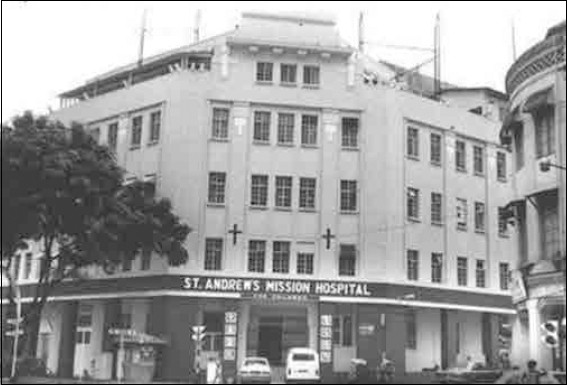Abstract
In Singapore, paediatrics as a separate discipline was started in 1921 at Singapore General Hospital (SGH). From Mistri Wing to Alexandra Hospital (AH) and Tan Tock Seng Hospital (TTSH), paediatrics was started at National University Hospital (NUH) and the Children’s Hospital at KK Women’s and Children’s Hospital (KKH) from 1997. After World War II, neonatology started in KKH, followed by Toa Payoh Hospital (TPH), AH, NUH and SGH. Neonates from TPH and AH were moved to KKH in 1990. Our pioneering giants include Dr Gopal Haridas, Professors Wong Hock Boon (First Paediatrics Professor), Tan Cheng Lim and Tan Kim Leong. Paediatrics in Singapore is resplendent with many achievements. Prof Wong identified the relationship of hyperbilirubinaemia/kernicterus with glucose-6-phosphate dehydrogenase (G6PD) deficiency and initiated G6PD deficiency screening. This has saved many lives and improved the overall health of children in Singapore. 100 years on, we stand firmly on the shoulders of our pioneering clinician giants as we face the paediatric millennial health needs of this new century.
INTRODUCTION
The term ‘paediatrics’ is derived from two Greek words: παĩς/pais (or child) and ίατρός/iatros (or doctor/healer). Having been in existence for only about 200 years, paediatrics is a relatively young discipline in the long passage of the history of medicine.(1-3) In 1802, the first paediatric hospital in the Western world, the ‘Hôpital des Enfants Malades’ (or the Hospital for Sick Children) opened on the site of a previous orphanage and cared for patients up to 15 years of age. Today, it exists as the paediatric division of the Necker-Enfants Malades Hospital, which was created following a merger with the Necker Hospital that was founded in 1778 for adults.(1,2) In the rest of Europe, the Charité in Berlin set up a separate paediatric pavilion in 1830 as did St. Petersburg in 1834 as well as Vienna and Breslau (now Wroclaw) in Poland, both in 1837. The Hospital for Sick Children was the first hospital in England to have inpatient paediatric care and opened with just 10 beds on Valentine’s Day, 14 February 1852. It is now known more widely as Great Ormond Street Hospital (or GOSH). It was founded by Dr Charles West (1816–1898), who specialised in paediatrics and obstetrics. Sir Frederic Still (1868–1941) was the first full-time consultant and professor of paediatrics in the UK and is considered as the Father of British Paediatrics. Sir Still was also the inaugural president of the British Paediatric Association.(1,2,4)
In the US, the first hospital for children opened in Philadelphia in 1855, followed by the Boston Children’s Hospital in 1869. Dr Abraham Jacobi, a German paediatrician who came to New York in 1853, is considered as the Father of Paediatrics in America.(1,2,5) In Canada, the Hospital for Sick Children (SickKids) was established in 1875 by Elizabeth McMaster, with Maggie, a three-year-old scalded child, as its first patient.
PAEDIATRICS AS A SEPARATE DISCIPLINE IN SINGAPORE’S EARLY YEARS
“The emergence of paediatrics as a special branch of medicine in Singapore can probably date back to the year 1921”, wrote Dr Constance Elaine Field in a paper entitled ‘The development of paediatrics in Singapore’ in 1962.(6-10) In 1921, the Singapore General Hospital (SGH, previously known as ‘General Hospital’ and ‘Outram Road General Hospital’) started providing inpatient medical care for children.
An editorial in the Malayan Medical Journal in 1936 states, “A reluctance to bring children to the practitioner of Western medicine has held up the study of paediatrics in this region”. This indicated the need for dedicated champions to apply Western paediatric medicine into the local community. In 1921, paediatric inpatient care at SGH was led by Dr Sarah Mary O’Flynn (later Lady Winstedt), Dr Richard Brunel-Hawes (later Sir RB Hawes) and Ms Ida Simmons, the Public Health Matron. They were also responsible for the successful setting up of the fledgling Maternal and Child Welfare services in colonial Singapore. Thus, 100 years ago and 100 years following the birth of SGH in 1821, paediatrics came into its own in Singapore, when children were admitted to SGH for inpatient care.
Professor Richard Brunel Hawes was Professor Gordon Arthur Ransome’s senior and was, as the late great Professor Seah Cheng Siang puts it, “an excellent clinician of the old type; he could smell diseases as it were”.(11) Prof Hawes was responsible to teach medical students in paediatrics and was appointed Head of the Department of Medicine at Tan Tock Seng Hospital (TTSH) in 1938. He guided and influenced Dr Gopal Haridas to take a special interest in paediatrics and child health when Dr Haridas was a tutor of medicine at TTSH from 1929 to 1932.
FATHER OF SINGAPORE PAEDIATRICS AND THE HARIDAS MEMORIAL LECTURE
Dr Gopal Haridas is the first Father of Paediatrics in Singapore. He was the first local hospital doctor to obtain the MRCP in 1933 after a period of postgraduate training at Great Ormond Street in Medicine and Children’s Diseases and was subsequently appointed part-time lecturer in Paediatrics. Dr Haridas later took charge of the two wards at SGH that were set aside for children, namely Wards 12 and 13, located at Level 2 in the Stanley Block. Formerly known as the ‘Middle Block’, it was used to house the second- and third-class female wards and was named after Dr Cuthbert Arthur Stanley, who was tortured to death by the Japanese in the 1940s. It was demolished in the 1970s and replaced by Block 8 at SGH.(12)
Infections and malnutrition accounted for a large number of cases that required admission to SGH (
Box 1
Common diseases in children requiring admission to Singapore General Hospital wards 12/13 (1933–1941):
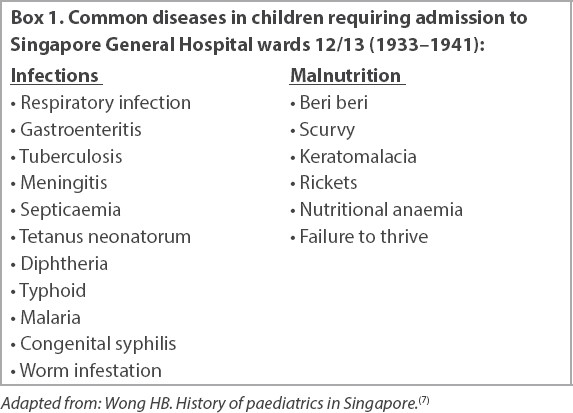
Dr Cicely Williams succeeded Dr Haridas in 1936, following his promotion to Chief Medical Officer at TTSH. Dr Haridas continued to serve as a paediatrician and part-time lecturer. During the Japanese Occupation, TTSH and the then Kandang Kerbau Hospital (KK Hospital) functioned as the Japanese Civil General Hospital. The latter was called ‘Chuo Byoin’ (Central Hospital) by the Japanese and had 12 children’s beds. KK Hospital’s maternity service was scaled down to one ward. It was manned by local and Japanese staff, with Dr Benjamin Sheares as the Deputy Medical Superintendent.(14) The Japanese commandeered SGH for their own casualties, and it became the main surgical centre for the Japanese army and navy in Southeast Asia.(14,15)
Dr Haridas resumed headship of paediatrics after the war in 1945 until he retired in 1954. The Haridas Memorial Lecture Fund was set up in memory of the ‘Father of Paediatrics’ in Singapore after he passed away in 1964. The first Haridas Memorial Lecture was delivered by Professor Wong Hock Boon in 1966 and was entitled ‘Haemoglobinopathies in Singapore’. Through the years, the distinguished Haridas Memorial speakers have included Drs Tan Kwang-Hoh, Freda Paul, Gary Tan SG, Loh Tee Fun, Chan Kim Yong, Tan Kim Leong (who spoke at two memorial lectures), William Yip, Eric Aiyathurai, Ho Ting Fei, Tan Siok Hoon, John Tay, Lee Wei Ling and Loke Kah Yin. The topics covered were kernicterus and cerebral palsy, mental retardation in Singapore, recent trends in infantile gastroenteritis, congenital heart disease in Singapore, epilepsy in children in Singapore, congenital rubella in Singapore; phototherapy, Reyes-like syndrome, childhood obesity among primary school children in Singapore – epidemiological review and anthropometric evaluation, thyroid disorders in Singapore children and adolescents, genetic counselling, febrile seizures in Singapore children and molecular characterisation of the CYP2 gene for congenital adrenal hyperplasia in Singapore. In 2018, Prof Ho Lai Yun delivered the 16th Haridas Memorial Lecture entitled ‘Building an Inclusive Early Childhood Intervention Ecosystem in Singapore 1988–2017’.
OUTPATIENT FOLLOW-UP AND DR WILLIAM HENG
The first referral and outpatient clinic for children was started by Dr William Heng. He returned from the UK in 1939 and worked in Wards 12 and 13 at SGH as House Physician. In September 1941, Dr Heng set up and ran the first follow-up liaison clinic for children from the ward, which soon developed into a children’s clinic to which cases were referred from the Infant Welfare Clinics, the private practitioners and later diverted from the general outpatients. Children of government employees were also seen at the clinic. Two sessions a week were reserved for the treatment of congenital syphilis, and biweekly injections of bismuth and oral arsenic. An important part of the follow-up clinic was dietetic education of the mothers, as beri beri was a commonly observed condition in newborns. The clinic grew rapidly until 50 to 60 patients were seen daily. Dr Heng had just one nurse and two ‘amahs’ (female service staff) as assistants.(6-10)
ST ANDREW’S MEDICAL MISSION AND PAEDIATRICS IN THE EARLY YEARS
The wife of the Bishop of Singapore, Dr (Mrs) CE Ferguson-Davie, had a mission to ‘minister to the physical and spiritual needs of those most neglected in society – women and children’. Thus, in 1913, the St Andrew’s Medical Mission (Anglican) in Singapore was founded. From a humble dispensary, it grew into a full-fledged St. Andrew’s Mission Hospital for Women & Children at Erskine Road in 1923. The hospital had 60 inpatient wards and an outpatient service.(6,7,15)
In 1939, the St Andrew’s Orthopaedic Hospital at Siglap was set up to treat children with tuberculosis of the bones and joints. Thereafter, the St Andrews’s Mission Hospital for Children was established in 1948 at Tanjong Pagar with 30 beds (
With the consolidation of national paediatric services in public institutions, demand for paediatric charity hospitals declined, and the inpatient services at St Andrew’s Mission’s Hospital ceased operations in 1982. The St Andrew’s Orthopaedic Hospital ceased operations in 1987.(16) In 2007, St Andrew’s Community Hospital became the first community hospital to provide paediatric inpatient rehabilitation services (
Box 2
Early years of paediatrics and child health in Singapore:
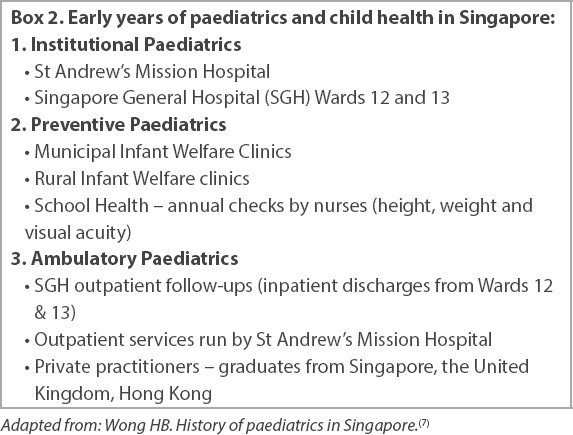
THE 1950S, THE SGH MISTRI WING AND TO THE 1980S
Mr Navroji Rastomji Mistri was a prominent Parsi entrepreneur, known as the ‘Bachelor Godfather’ of Singapore’s poor children and ‘Godfather of the Poor’. He had made his fortune selling soda water. He was a patient of Professor Arthur Ransome and, in June 1952, donated S$950,000, a kingly sum in those colonial times, to SGH for the building of a third-class ward for non-paying paediatric patients. “I cannot bear to think of sick children and their mothers lying on the floors of hospital wards…I donated my recent gift of S$950,000 because I thought it was my duty to do something for Singapore’s children”.(17,18) With this significant donation from Mr Mistri, the government subsequently built a S$1,500,000 block for sick children at SGH. This was a four-storey building with 280 beds/cots. There were eight wards in the Mistri Wing, built in cubicle style with only partial enclosure, thus maintaining the cross ventilation that is important for preventing cross infection (
Fig. 2
Mistri Wing for Paediatrics at the Singapore General Hospital.

Dr Haridas retired in 1954, and Dr Quah Quee Guan ran the unit until Dr Elaine Field, who had previously trained at Great Ormond Street Hospital, assumed headship of SGH Paediatrics in April 1955.(6-10) Dr Field also served as the Second Master of Academy of Medicine, Singapore from 1959 to 1960. In 1962, she left for Hong Kong, where she became the Founder Professor of Paediatrics at the Hong Kong University.
In 1951, Dr Louis Sammy, in memory of his sister Jane, set up the annual ‘Jane Prize’ for ‘the best essay by a final year student’ on ‘their own original observations on children’.(6) Prof Wong Hock Boon was awarded a scholarship to the UK for postgraduate studies in paediatrics in 1956 and returned to Singapore in 1957 after passing the requisite examinations. In 1960, Dr Field proposed to the University of Singapore to establish a Chair in Paediatrics to ‘foster the teaching of paediatrics to both the undergraduates and the postgraduates, so that Singapore will be able to train more doctors to be specialists in Paediatric Medicine’. Prof Wong Hock Boon was appointed the Founder Professor of Paediatrics in Singapore in 1962 (
Fig. 3
Prof Wong Hock Boon, our first Professor of Paediatrics.
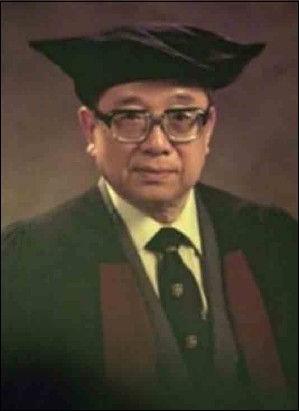
PHOTO GALLERY
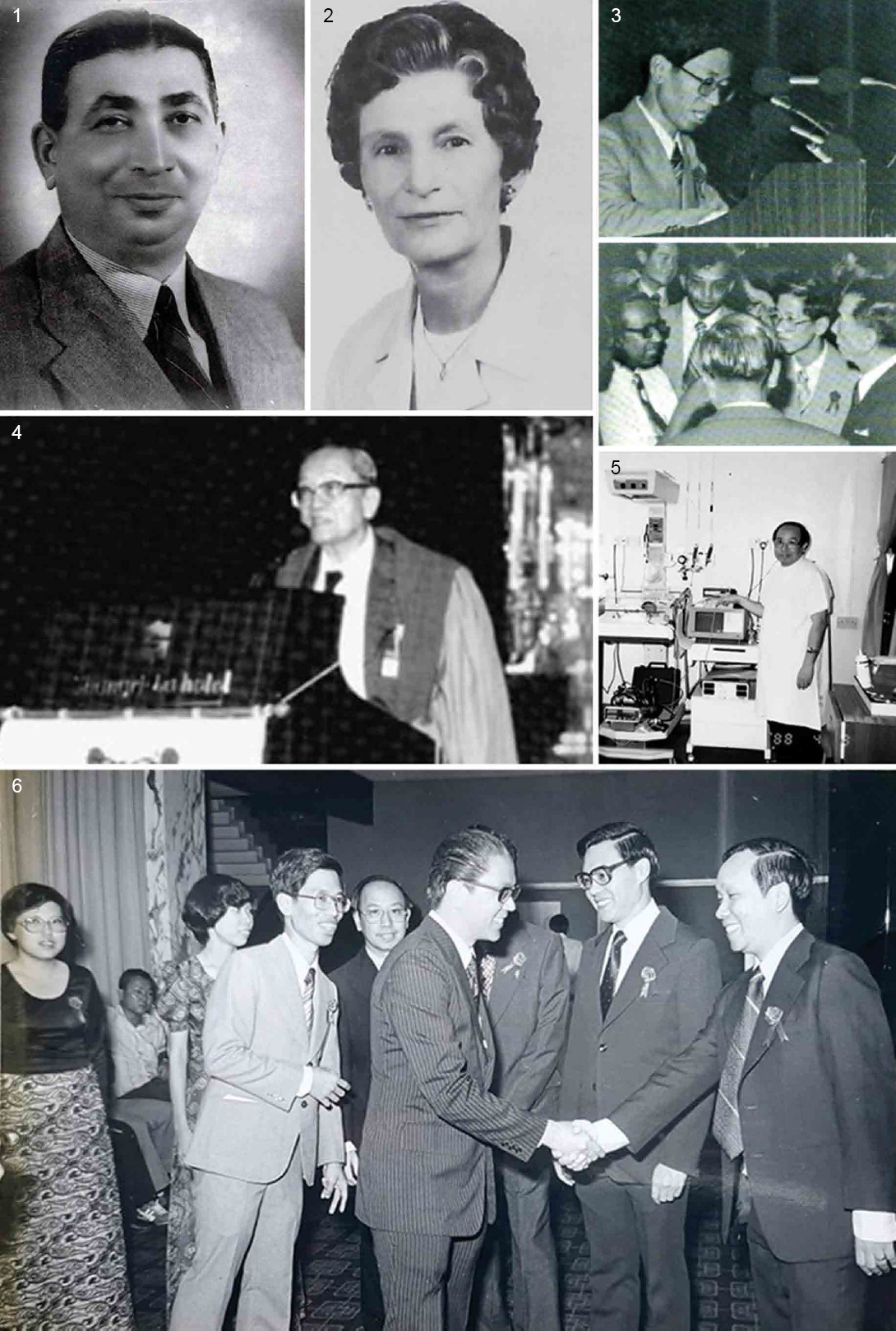
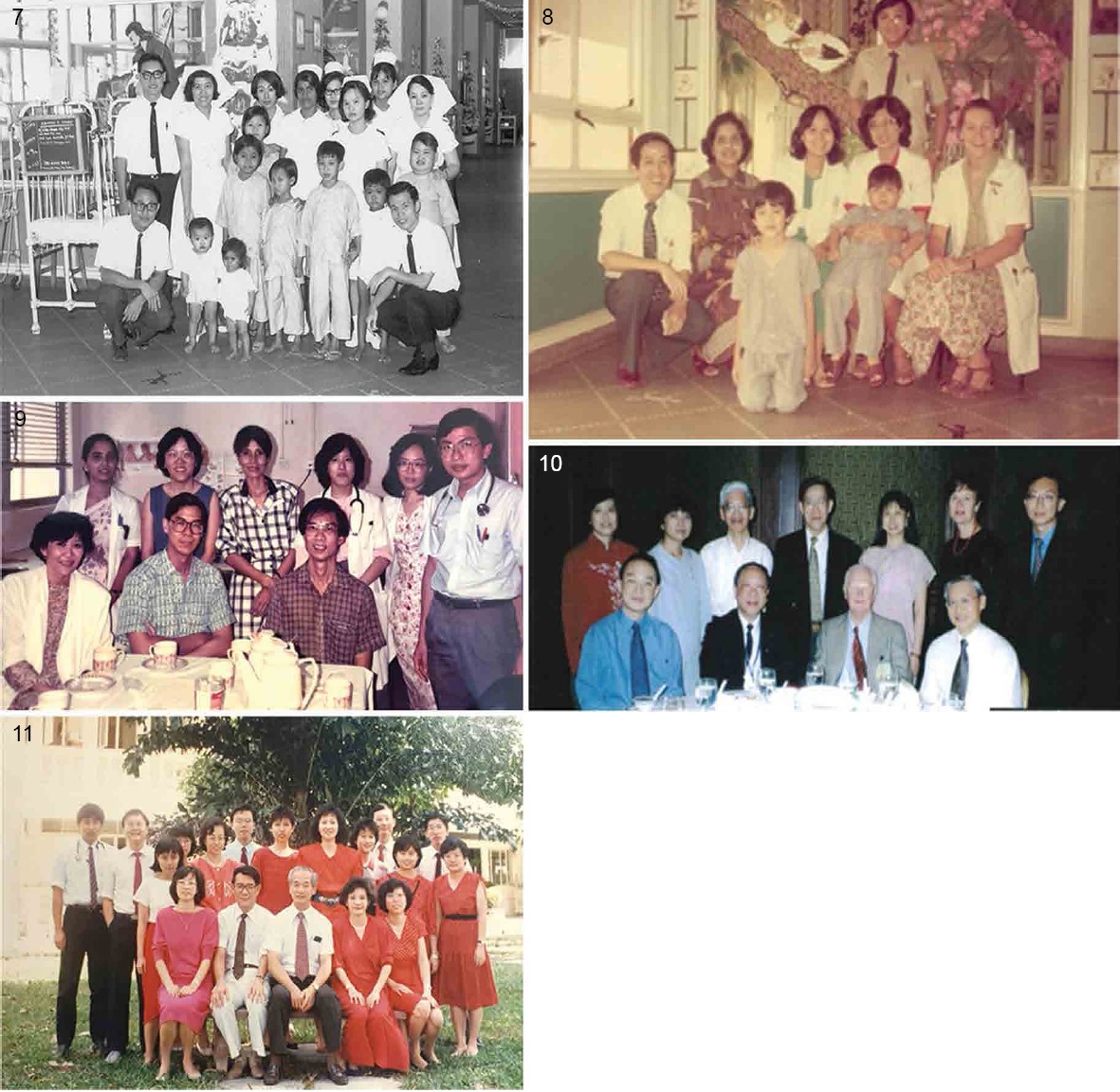
-
Paediatric benefactor, Mr NR Mistri
-
Dr Constance Elaine Field
-
Prof Phua Kong Boo at the ‘Today’s Children, Tomorrow’s Nation’ Convention, organised by the Singapore Paediatric Society, Celebrating International Year of the Child 1979 – with President Benjamin Sheares
-
Emeritus Professor Wong Hock Boon delivering the inaugural Chapter of Paediatricians Lecture, ‘The Future of Medicine from the Standpoint of the Practising Paediatrician’ at the Opening Ceremony of the 9th ASEAN Paediatric Federation Conference in 1998
-
Prof Ho Nai Kiong at the Neonatal Department, Toa Payoh Hospital
-
Profs Phua Kong Boo, Ho Nai Kiong, Tan Cheng Lim and Ho Lai Yun with Dr Tony Tan at the Singapore Paediatric Society Convention in 1979
-
Prof Tan Cheng Lim (standing far left) with staff and patients at a ward at Mistri Wing (Paeds East)
-
Christmas 1978/9 at Mistri Wing (Paeds West): Prof Quak Seng Hock (far left), Dr Freda Paul (seated 2nd from left) and Prof Yap Hui Kim (seated 2nd from right)
-
Department of Paediatrics, Alexandra Hospital: Dr Frances Chia (seated far left), visiting expert from Australia, Dr Victor Yu (seated 2nd from left), Dr Tan Keng Wee (seated 3rd from left); standing: Dr Malathi (far left), Dr Choong Chew Thye (3rd from left), Dr Daisy Chan (4th from left) and Dr Loke Hing Leng (5th from left)
-
The 50th anniversary celebration of the Singapore Paediatric Society in 2002: Prof Ho Lai Yun (seated 2nd left) with Dr G Keys Smith (seated 3rd left) and Prof Tan Cheng Lim (seated far right)
-
Department of Paediatrics, Tan Tock Seng Hospital: (seated left to right) Drs Tan Ah Moy, Lim Khim Wee, Cheng Heng Kock, June Lou and Tan Chor Kiang, with Drs Sylvia Choo and Chay Oh Moh (standing behind Dr Tan Ah Moy)
Each wing had three 40-bedded wards from Levels 2 to 4 and an admitting ward of 20 beds on the ground floor.(9) When combined, there were 280 inpatient beds in total for paediatrics in Mistri Wing. Prof Wong led Paeds West while Dr Tan Kwang-Hoh led Paeds East from 1964 to 1969 and was succeeded by Dr Chan Sing Kit in 1969. Paeds West also ran the neonatal unit at KK Hospital (led by Prof KL Tan and Dr Thomas Wong), and Paeds East ran the neonatal unit at TPH, established as Thomson Hospital for the Chronic Sick in 1959 and renamed the Thomson General Hospital in 1968, later becoming TPH in 1975. A key milestone during this period that greatly reduced neonatal mortality related to neonatal jaundice was the introduction of phototherapy by Dr KL Tan at KK Hospital. Paeds East and Paeds West at Mistri Wing, SGH continued to care for children up to the mid-1980s. Both Paeds East and Paeds West shared a small two-to-four-bedded paediatric intensive care unit located at Ward 26.(6-10) Paediatric Surgery was formally introduced in 1972 at SGH, and the Department of Paediatric Surgery, SGH was established in 1981.(9)
PAEDIATRICS AT AH AND TTSH
In 1971, a paediatric department was set up at AH (
Fig. 4
Alexandra Hospital Paediatric and Neonatology Department in the 1980s. [Photographs courtesy of Dr Tan KW].
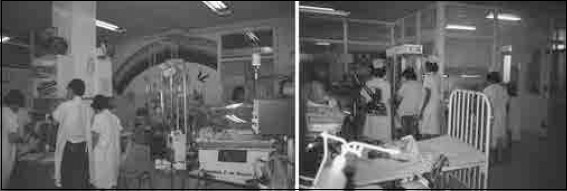
PAEDIATRICS AT SGH AND NUH
With the transformation of University of Singapore to the National University of Singapore at Kent Ridge in 1984, the NUH was established. This marked the end of a significant era in Singapore Paediatrics when Paeds West shifted over to NUH in 1985 with Prof Wong as the Head. Paeds East remained in SGH campus as the Department of Paediatrics SGH, with Prof Tan Cheng Lim as the Head.
NEONATOLOGY IN SINGAPORE
While it was only in 1960 that Dr Alexander Schaffer first coined the term ‘neonatology’ addressing the special needs and concerns of newborns, Singapore provided care for the newborns way before this, as did many other countries worldwide. KKH was set up in 1858 as a general hospital and became a maternity hospital in 1924. Dr Elaine Field, Head of SGH Paediatrics, was tasked to care for the newborns at KKH soon after her arrival. Dr Gwen Smith later joined Dr Field and took over the major part of the paediatric developments at the KK Maternity Hospital.(6) Dr Smith established exchange transfusions for the jaundiced babies and developed a separate unit for 36 premature babies. In 1966, KKH delivered 39,835 babies, recording the most number of babies born in a single hospital, and was featured in the Guinness Book of World Records (
Fig. 5
Kandang Kerbau Maternity Hospital Guinness Book of Records with 39,835 deliveries in 1966.
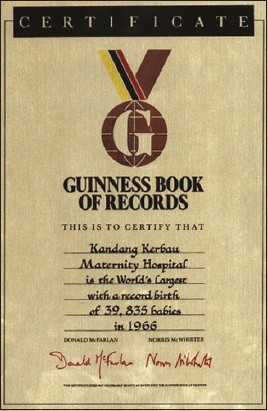
Thomson Road Hospital located at Toa Payoh Rise was set up in 1959 and took care of the chronic sick. It was renamed Thomson Road General Hospital (TRGH) in 1968 and subsequently renamed Toa Payoh Hospital (TPH) in 1975.(19) Paediatric East ran the neonatal services for the O and G unit in TRGH in 1969 when an obstetric unit opened, with around 5,000 deliveries a year.(20) Prof Ho Nai Kiong was sent to TRGH from Paediatric East in 1972 to take charge of newborn services after he passed his Master of Medicine (MMed) examinations in 1971. In 1977, the Neonatal Department was established at TPH and Prof Ho was appointed the first Head of the Department. Thus, this department became the first government department providing full-time neonatal services in Singapore.(21,22)
One of the outstanding and landmark achievements in neonatology in Singapore was by Prof Wong Hock Boon, who identified the relationship of hyperbilirubinaemia and kernicterus with G6PD deficiency in newborns. Prof Wong subsequently initiated screening for G6PD deficiency in cord blood, which has saved many lives and improved the overall health of children in Singapore. The first clinical trial of exogenous surfactant for respiratory distress syndrome in newborns was conducted in 1965 in KKH. In 1991, Prof Ho Nai Kiong was invited to conduct the international collaborative trial of synthetic exogenous surfactant Exosurf worldwide (the OSIRIS trial) with 36 countries. Singapore was the only Asian country to participate in this important international neonatal trial.(23,24)
The Neonatal Unit at AH was set up in 1971 under the Paediatric Department to support AH’s ‘busiest department’, Obstetrics and Gynaecology,(25) with 5,000 annual deliveries.(20) With the shift of Paeds West to the National University of Singapore in 1985, a neonatal service was established at NUH. SGH set up its neonatal department in December 1986. Soon after, in 1989, with the restructuring of KKH, the neonatal departments from TPH and AH moved to KKH as Neonatal Departments 1 and 2 or NN1 and NN2, respectively.
PAEDIATRICS AND NEONATOLOGY AT KKH
In the 1990s, the MOH decided to set up KK Women’s and Children’s Hospital and organised visits to the US and Australia to study the model of similar maternal and child hospitals. Dr Tan Keng Wee chaired the MOH neonatal workgroup. On 10 March 1997, the O&G and neonatal departments moved from the old facilities to the new hospital.(26) Dr Tan served as Head of Department of Neonatology of the new KKH from 1997 to 2001, and Prof Ho Nai Kiong served as the hospital’s first Divisional Chair of Paediatrics. Two months later, on 10 May 1997, the three departments of paediatric medicine from SGH, TTSH and AH, together with the SGH Department of Paediatric Surgery, moved over to KKH.
POSTGRADUATE PAEDIATRIC SPECIALIST TRAINING IN SINGAPORE
After the war and before 1970, postgraduate paediatric training was obtained overseas through scholarship awards. This was what Prof Wong termed ‘Phase 1’ of Singapore’s paediatric postgraduate training.(7) In 1960, the then University of Singapore set up a Postgraduate Board of the Faculty of Medicine, and Prof Wong was appointed Chairman of this committee to facilitate this collaboration between the Australasian Colleges of Medicine and Singapore. During this period, the Royal Colleges of Australasia agreed to hold postgraduate lectures in Singapore. Our local doctors would then go to Australia for practical exposure, take their postgraduate examinations in Australia and obtain their MRACP and FRCAS from the Australasian colleges (Phase 2).
The Vice Chancellor of University of Singapore in 1970 set up the Postgraduate Medical School. This was an independent body from the Faculty of Medicine and was ‘subordinate to the senate of the university’. The board members included representatives from the MOH, Faculty of Medicine and the Academy of Medicine Singapore. The higher clinical qualification was designated Master of Medicine (MMed). Prof Wong was appointed the first Foundation Director of the school.
Initially, only three disciplines were selected, namely Internal Medicine, Surgery and Obstetrics. Prof Wong pushed to include Paediatrics, which was eventually accepted by the board. There were 11 candidates for the first MMed (Paeds) examinations, of whom the following five successfully passed: Dr Cheng Heng Kock, Dr Tan Keng Wee, Dr Foong Yew Chun, Dr Lee Seow Lang and Dr Ong Eng San. Hence, Singapore moved into Phase 3 of postgraduate training of its paediatric specialists (
Table I
Development of Postgraduate Paediatric Specialist Training after World War II.

In 2006, neonatology was recognised as a subspecialty within Paediatrics by the Specialist Accreditation Board (SAB), Singapore Medical Council. In 2018, five additional paediatric subspecialties, namely paediatric cardiology, paediatric intensive care medicine, paediatric gastroenterology, paediatric haematology and oncology, and paediatric nephrology were recognised by the SAB.
SINGAPORE PAEDIATRIC SOCIETY AND THE COLLEGE OF PAEDIATRICS AND CHILD HEALTH, SINGAPORE
Singapore Paediatric Society
The Singapore Paediatric Society (SPS) was founded in 1952. 22 doctors were present at the first meeting held on 1 August 1952, and Dr Haridas was the first president of SPS. Meetings were held in SGH and at St Andrew’s Hospital once or twice a year, with an annual weekend conference. SPS organised the First Asian Regional Paediatric Congress in May 1958. The congress had 192 participants from Singapore, Malaya and 17 other countries. Many of the papers were subsequently published in a 1958 issue of Indian Journal of Child Health.(6-8,27) In 1959, Prof Wong started the ‘Journal of the Singapore Paediatric Society’ (
Fig. 6
First issue of the Journal of the Singapore Paediatric Society, October 1959.
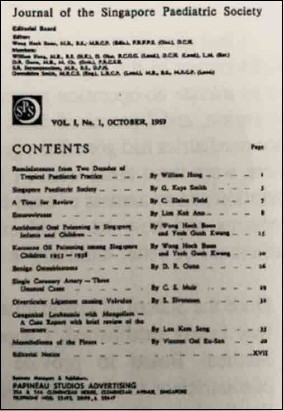
College of Paediatrics & Child Health, Singapore, Academy of Medicine
The College of Paediatrics and Child Health, Singapore (CPCHS), Academy of Medicine started as the Chapter of Paediatrics and Child Health in 1989 to look after the interests of paediatricians in the Academy of Medicine.(8,28,29) The inaugural meeting was held on 31 March, with the Master, Academy of Medicine, Dr NC Tan chairing the meeting. The inaugural chapter office holders were Dr Tan Kim Leong (chairman), Dr Ho Nai Kiong (Vice Chairman) and Dr Chay Oh Moh (Honorary Treasurer), with Dr Phua Kong Boo, Dr Yap Boh Ghee and Dr June Lou as committee members.
The chapter evolved into the CPCHS, Singapore 15 years later, and CPCHS was incorporated on 17 August 2004. The first elected office bearers of the College were Dr Quak Seng Hock (President); Dr Ho Lai Yun (Vice-President); Dr Goh Yam Thiam, Daniel (Honorary Secretary); Dr Rajadurai Victor, Samuel (Honorary Treasurer) and Drs Goh Eng Kim, Anne/Chan Kwai Lin, Daisy and Lee Bee Wah (council members) (
Fig. 7
The first elected office bearers of the College of Paediatrics and Child Health, Singapore: back row (L to R) Dr Rajadurai Victor, Samuel (Honorary Treasurer), Dr Quak Seng Hock (President), Dr Low Cheng Hock (Master of Academy of Medicine Singapore); front (L to R) Dr Ho Lai Yun (Vice-President), Dr Chan Kwai Lin, Daisy (Council Member), Dr Goh Yam Thiam, Daniel (Honorary Secretary), Dr Lee Bee Wah (Council Member), Dr Goh Eng Kim, Anne (not in picture). [Reproduced from Quak et al. Recent Development in Paediatrics: from Chapter to College(28)].
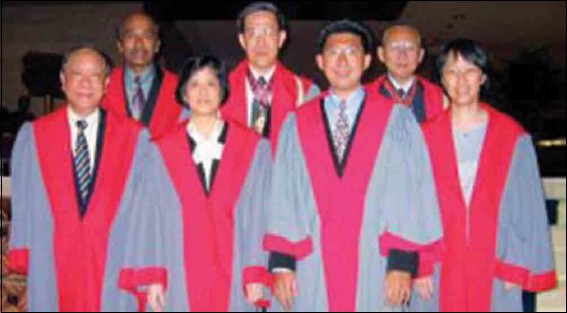
In the CPCHS Coat of Arms of the College, designed by its members, the chevron at the centre of the shield symbolises the coming together of all medical specialties to provide the best medicine care for the nation. The two children represent paediatrics and healthy children. The snake coiling around the rod symbolises ‘healing’. The four circular red dots joined together by olive leaves symbolise the four races living harmoniously in Singapore and in the pink of health. Supporting the shield are two lions, which represent Singapore. The olive branches symbolise anointing and medicinal values. The motto ‘Recta Sapere’ urges us to seek and savour the truth at all times(28) (
Fig. 8
Coat of Arms of the College of Paediatrics and Child Health, Singapore. [Reproduced from Quak et al. Recent Development in Paediatrics: from Chapter to College(28)].
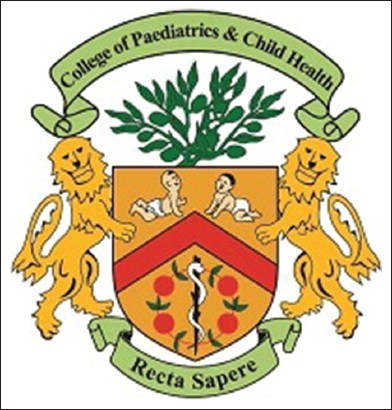
The Chapter, and later, the College Lecture is open to distinguished members of the medical profession by invitation (local as well as overseas), with the subject offered for the lecture being scientific in content and in the field of paediatrics. Prof Wong Hock Boon delivered the first lecture for the Chapter in 1998 – ‘The Future of Medicine from the Standpoint of the Practising Paediatrician’ and Prof Tan Cheng Lim delivered the next in 2000, entitled ‘The Future of Paediatrics in Singapore’.
The Stuart Gan Memorial Fund was set up in memory of an unfortunate boy who succumbed to an indeterminate immunodeficiency syndrome. The objectives of this fund are to organise and support activities and events related to the genetic, antenatal diagnosis, prevention and other related fields pertaining to immunodeficiency states. These activities include research projects, seminars or lectureships. Since its inauguration, the Stuart Gan Memorial Fund has enabled several prominent speakers to be invited to Singapore to deliver lectures on immunodeficiency and related topics.
In 2012, the CPCHS, SPS and Singapore Perinatal Society jointly organised an annual scientific meeting called the ‘Singapore Paediatric and Perinatal Annual Congress’ or SiPPAC. In March 2021, CPCHS and SiPPAC partnered with the UK Royal College of Paediatrics and Child Health (RPCPCH) and held the first ever international RCPCH-partnered academic conference entitled ‘Learning Together to Improve Child Heath’. This webinar meeting drew more than 700 participants from around this region and also across the world.
CONCLUSION
Paediatrics and child health in Singapore have improved tremendously over the last 100 years. Our paediatric fraternity has been blessed with great academic clinician leaders who have led our discipline in Singapore through the war and into independence, and into the 21st century. The health needs of our children have evolved, reflecting our first-world environment. Among some of these key health needs for children in this century are what Judith Palfrey terms the ‘millennial morbidities’ – the primarily metabolic and mental wellness of our children (
Box 3
Paediatric morbidities over the centuries:
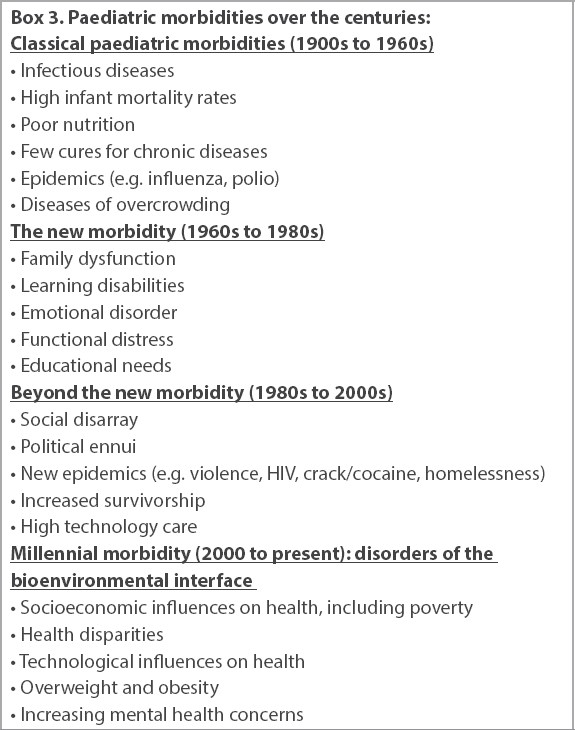
ACKNOWLEDGEMENTS
We would like to thank the SPS for their kind permission to reproduce the photos from the Journal of the SPS and the CPCHS.



